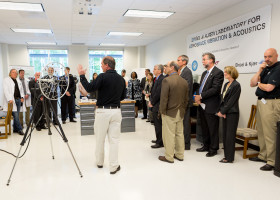NEW AEROSPACE VIBRATION AND ACOUSTICS LAB OPENS DOORS TO ADVANCED RESEARCH
Hampton, Va. – On Thursday April 12, local, regional, and commonwealth officials joined researchers, engineers, and students at a dedication ceremony celebrating the new National Institute of Aerospace Research and Innovation Laboratories at 1100 Exploration Way, in Hampton, Virginia. The 58,000 square-foot building is owned by Virginia Tech and overseen by the institute, who holds a long-term lease on the property.
As part of the facilities within the NIA Labs, the Bruel & Kaejer Laboratory for Aerospace Vibration and Acoustics is directed by Virginia Tech’s Samuel Langley Distinguished Professor of Engineering, Christopher R. Fuller. Fuller is an expert in acoustics and noise and vibration control and is noted for his distinguished work on control of the interior noise and vibration in aerospace applications, launch vehicle payload noise, and other related concerns in the automotive and marine industries.
Under a unique arrangement with NIA, the laboratory is sponsored by Bruel & Kjaer, world leaders in instrumentation and software for acoustic and vibration measurements and analysis. The laboratory contains state of the art instrumentation and equipment for measuring and analyzing vibration and sound.
“I am very pleased that a world renowned company such as Bruel & Kjaer has agreed to sponsor our laboratory” remarked Fuller. “The sponsorship and interaction with Bruel & Kjaer will undoubtedly lead to a significant increase in the quality and reputation of the work and education performed in our laboratory.”
Bill Wright, Bruel & Kjaer Application Engineer for the Mid Atlantic Region added, “Bruel & Kjaer is pleased to be helping with this partnership to ensure that NIA students can benefit from B&K’s core sound and vibration knowledge and our multiple and dedicated solutions for core markets such as aerospace, defense, electro acoustics and medical.”
The laboratory will support education in acoustics and vibration and enable advanced research on analyzing, understanding, and developing innovative solutions for noise and vibration problems in aircraft, rotorcraft, and spacecraft. Active noise control still offers much potential for the reduction of aircraft exterior noise and research in that area will be carried out in the new facility. Fuller noted, “One of NASA’s important goals is the development of environmentally friendly aircraft, and noise is a key aspect of this program. The work in this new lab will support NASA and the commercial aviation industry in developing quieter engines, airframe noise and interior noise in aircraft and rotorcraft.”
Multi-functional and advanced acoustic materials that reduce vibration and harvest energy will also be studied, as vibration control is an important consideration in designing efficient aircraft and space structures. Research conducted in the lab will help enable applications of acoustics to medicine as well.
Future directions in acoustics and vibration research to be considered in the laboratory include the investigation of meta acoustic materials which combine advances in nano and material technologies to create lightweight sound absorbing materials with increased performance. The combination of microbiology and materials may lead to genetically grown materials which have improved vibration and noise reduction qualities.

